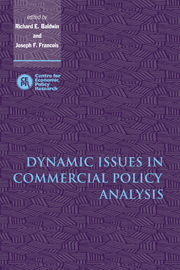Book contents
- Frontmatter
- Contents
- List of figures
- List of tables
- Preface
- List of conference participants
- 1 Introduction
- 2 Transition dynamics and trade policy reform in developing countries
- 3 Putting growth effects in computable equilibrium trade models
- 4 Innovation, capital accumulation, and economic transition
- 5 Multinational production, skilled labour, and real wages
- 6 Economic policy and the manufacturing base: hysteresis in location
- 7 Trade liberalization and investment in a multilateral framework
- 8 Investment creation and investment diversion: simulation analysis of the Single Market programme
- 9 Blueprints, spillovers, and the dynamic gains from trade liberalization in a small open economy
- 10 Trade policy and North–South migration
- 11 Long-term modelling of trade and environmental linkages
- 12 Labour markets and dynamic comparative advantage
- Index
10 - Trade policy and North–South migration
Published online by Cambridge University Press: 13 January 2010
- Frontmatter
- Contents
- List of figures
- List of tables
- Preface
- List of conference participants
- 1 Introduction
- 2 Transition dynamics and trade policy reform in developing countries
- 3 Putting growth effects in computable equilibrium trade models
- 4 Innovation, capital accumulation, and economic transition
- 5 Multinational production, skilled labour, and real wages
- 6 Economic policy and the manufacturing base: hysteresis in location
- 7 Trade liberalization and investment in a multilateral framework
- 8 Investment creation and investment diversion: simulation analysis of the Single Market programme
- 9 Blueprints, spillovers, and the dynamic gains from trade liberalization in a small open economy
- 10 Trade policy and North–South migration
- 11 Long-term modelling of trade and environmental linkages
- 12 Labour markets and dynamic comparative advantage
- Index
Summary
Introduction
Differential rates of population growth between North and South represent a phenomenon of first-rate importance, with implications for patterns of trade, migration, and the distribution of the gains from economic activity both within and between nations. After similar increases in population in the first half of the twentieth century, the second half of the century has been characterized by an extraordinarily rapid increase in Southern population relative to the North, with a continuation of that trend expected through the twenty-first century (see Table 10.1). The percentage increase in Northern population was 44 per cent from 1950 to 1990, and is projected to increase by 24 per cent from 1990 to 2100. At the same time, the Southern population increased by 143 per cent in the post-war period and is projected to increase by another 150 per cent over the twenty-first century. With land fixed, and under most reasonable estimates of physical and human capital creation, these data suggest a potentially rapid divergence in relative endowments between North and South. In an even moderately open world economy, relative endowment changes of this magnitude can reasonably be expected to play a substantial role in any explanations offered for change in wages, employment, and welfare.
The trend in differential population growth is given added significance by its perceived connection to the emergence over the past decade and a half of increasing inequality of earnings in the United States and increasing levels of unemployment in Europe. An exploding body of literature seeks to theoretically characterize and empirically evaluate the causes of increasing inequality in advanced industrial economies.
- Type
- Chapter
- Information
- Dynamic Issues in Commercial Policy Analysis , pp. 323 - 344Publisher: Cambridge University PressPrint publication year: 1999



